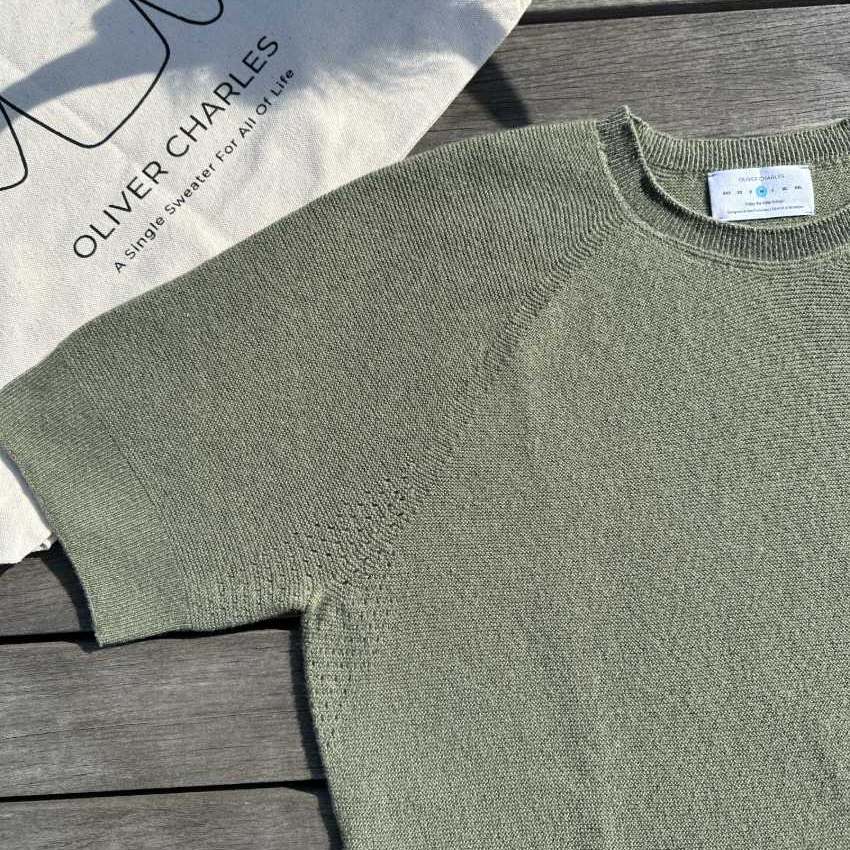Sustainable Sweaters: Superficial Or Deeply Consequential?
Our clothing choices play a significant role in reducing waste and pollution.
October 26, 2023
By Lia Klinchik
Living On The Road: The Cardigan I Always Pack
Introducing the 3rd blog in my 3-part blog series about the best ways to enjoy the Sierra Nevada, packing for summer road trips, and sustainability throughout your travels.
----------
How often do you ask what’s in your clothing? You may not think about it a lot, and that makes sense. I certainly didn't. I mean, it’s not food, after all, so why ask about the ingredients? But most of the clothing materials out there are negatively contributing to the changes our planet is experiencing.
When we pick up a shirt, pants, or a sweater, we should be asking ourselves, "what is this made from?"
While field testing the Oliver Charles Summer Cardigan and various yak wool sweaters, I researched the materials used to create them in search of how sustainable they really are.
Opting for sustainable materials such as yak wool, SeaCell, merino, and organic cotton is a step towards a brighter future for our planet. The journey to make a positive change begins with the choices we make in our wardrobe.

How Yak Wool Excels In Sustainability
Fast fashion has a vast climate footprint. There’s something luxurious about buying something brand new. It can be hard to believe or simply realize that when you purchase a shirt, you’re having an influence on the environment.
How often are we aware of where our money is actually going, and all that was put into the making of our clothes? Where were they made? Who were they made by? How much energy did it take, and what amount of water was used to produce this material? Most companies aren’t transparent about these basic questions!
Fast fashion contributes to a massive amount of water consumption, plastic microfiber pollution, and carbon emissions.
I looked into the relationships and habits of yaks to determine whether or not yak wool is as great as it seems.
Yaks are a significant part of communities in Asian highlands. What I learned was that yaks have a grazing system that allows for maximum efficiency in their homelands, preventing damage and moving with the seasons. This has affected the way we consider what range sustainability looks like.
A fascinating article published in 2022 explores yak energy and nitrogen metabolism, carbon emissions, and how they are able to adapt to extreme temperatures. Their wool is an example of one of these adaptations.
Because yaks are native to their habitat and maintain grazing behavior that they’ve had for countless years, they are not detrimental to the environment or native grasses.
Yak wool is a perfect example of what we should look for in terms of an intentionally sourced clothing material!

Why SeaCell And Organic Cotton Excel In Sustainability
There’s a lot of talk surrounding these fancy natural materials. SeaCell? Organic cotton? What are they?
SeaCell is a fabric created from seaweed and wood pulp. This pulp derives from both Eucalyptus and Beech trees. Did you know that Eucalyptus trees were introduced from Australia and are invasive in Southern California? These basic materials are then reconstructed and spun into usable fibers.
Unlike other similar fibers, the process doesn’t require carbon disulfide (a toxic chemical) to be produced.
Oliver Charles also outlines their processing and how seaweed and trees are harvested for the purpose of making clothing. This results in a safer environment for workers and less pollution.
Now, most people are familiar with cotton. The production of typical cotton has a lot of environmental implications due to poor labor environments, practices, and toxic runoff into water in the places where cotton is grown and harvested. This is one of the main reasons why choosing organic cotton is so important. Without the use of pesticides or fertilizers, it eliminates that result.
The wonderful thing about both of these materials is that there are fewer byproducts being shed into our ecosystems.

Investing In An Ethically Made Sweater
Our desire to connect with the natural world, beyond the times we section off to escape from work, is what informs our decisions. This is what I call buying for a better tomorrow.
What I love about Oliver Charles’ clothing is that you don’t have to think about the above if you don’t want to.
Rest assured, the Summer Cardigan was developed with not only comfort and versatility but nature in mind. It’s empowering knowing where your money is going.
And buying a few durable, versatile pieces has less of an environmental impact than 100 cheap items you’ll throw away and repurchase.
So here’s my favorite part: how what you choose to wear connects you deeper to the places you live and travel to.
We all love going out into the outdoors, taking a weekend hike, or day trips to the beach.
Our clothing reflects this. When we understand the materials holding our bodies, we notice how close we are to the whole process.

In today's world, where climate change and environmental degradation are pressing concerns, the choices we make in every aspect of our lives bear profound implications. Among these decisions is one that might seem superficial at first glance, but in reality, is deeply consequential: our choice of clothing.
If you believe that every good wardrobe starts with owning less and owning better, consider buying yourself an OLIVER CHARLES sweater.
Shop NowSustainable Sweaters For Self-Care
How investing in a sustainable wardrobe benefits our mental health.
Read more7 Day Challenge: Yak Wool Is Perfect For Winter And Spring
Testing the Oliver Charles All Season Boat Neck in classic Wyoming winter activities.
Read moreSeasonal Minimalist Wardrobe Is Out
All you need is one Oliver Charles sweater for all seasons.
Read moreThis Yak Wool Sweater Elevated My Wedding Weekend Wardrobe
How I stayed comfortable and stylish in a sweater during my wedding festivities.
Read more



